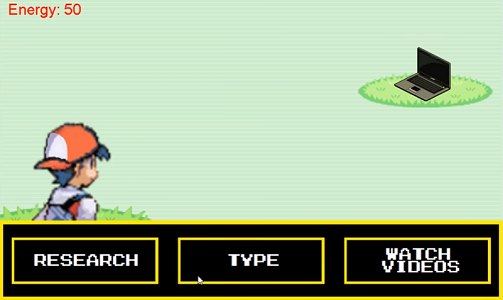College RPG


This project was created in Spring 2016 as a final project for ICS 111 -the first course for Java Object-Oriented Programming. My partner and I created a game which combined RPG and point-and-click aspects. The objective of the game is to “battle” college assignments to achieve a passing grade to win. The player must monitor their energy to ensure they are able to “battle” the assignments, they may also use purchased items from the shop to restore energy or increase their grade.
Because there were only two of us, the work for this project was evenly split between my partner and I. For this project I found the images/music, created the text boxes, created the class for the sprite to move and interact with assignments, created the class for the “battle” sequences, and created functions to determine the end game results.
You can see a demonstration of the program here YouTube
Included below is a function from the “Character” class used to animate the sprite when the player moved it upwards. This was the first programming class I took and it really sparked my interest in coding since most of our programs included animation and gaming. Getting used to the format of coding was difficult at first, nested loop got confusing quickly and it was sometimes difficult for my partner and I to decipher bugs in our code; these set backs emphasized how important it is to seek help with problems you don’t understand. Our TA for the course was able to help us understand the issues in our code and how to approach debugging our program. Looking back on this code, I think I could write more concise code with less comments. In this course we also used a class that contained functions written by the professor’s previous students to simplify coding to a display; I’d be interested in creating more projects like this in the future, it could be a good reminder of what I like about programming and help me to discover other fields I’m interested in.
void goUp(){ //create function called goUp that returns type void
for(int i=0; i<UPsequence.size(); i++){//create for loop that declares int i and initializes it with 0,
performs loop when i is less than the size of the UPsequence, and adds one to i after each loop
DOWNsequence.get(i).hide(); //hide object in index i of the arraylist DOWNsequence
RIGHTsequence.get(i).hide(); //hide object in index i of the arraylist RIGHTsequence
LEFTsequence.get(i).hide(); //hide object in index i of the arraylist LEFTsequence
}
counter++; //add one to counter
if(counter == TIME_STEP){ //if counter is the same value as TIME_STEP
counter = 0; //set counter to 0
posy = posy-15; //initialize posy with posy-15
int next_index = (index+1)%UPsequence.size(); //declare int called next_index and initialize it with the remainder of
(index+1)/the UPsequence size
UPsequence.get(index).hide(); //hide object in index of the arraylist UPsequence
UPsequence.get(next_index).show(); //show object in next_index of the arraylist UPsequence
index = next_index; //initialize index with next_index
UPsequence.get(index).translateTo(posx, posy-15); //translate the index of UPsequence to (posx, posy-15)
}
}